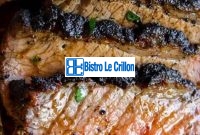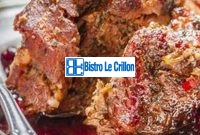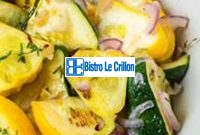Are you ready to take your culinary skills to the next level and impress your friends and family with a mouthwatering dish? Look no further than mastering the art of cooking lamb shoulder. This tender and flavorful cut of meat is a favorite among food enthusiasts, and once you learn the secrets of preparing it to perfection, you’ll become the talk of the town. In this article, we will guide you through the steps of cooking a succulent lamb shoulder that will have everyone coming back for seconds. But before we dive into the cooking process, let’s first explore the beauty of this delectable dish. ️
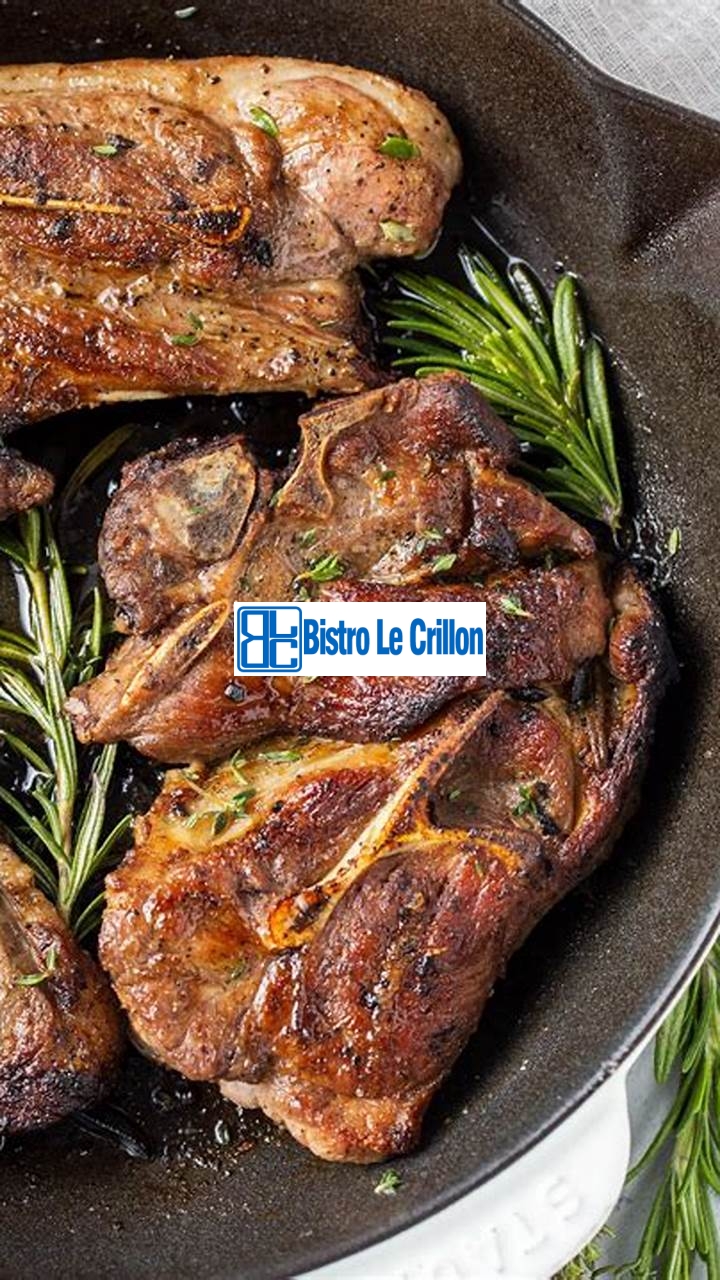
Choosing the Perfect Cut of Lamb Shoulder
When it comes to cooking lamb shoulder, selecting the right cut is crucial to achieving a delicious and tender result. With various types of lamb shoulder cuts available, it can be overwhelming to determine which one is best suited for your recipe. In this guide, we will walk you through the different cuts of lamb shoulder and provide essential factors to consider when making your selection.
Different Cuts of Lamb Shoulder
Before diving into the factors for choosing the perfect cut, let’s familiarize ourselves with the different options available:
- Shoulder Blade Chops: These chops come from the blade portion of the lamb shoulder. They are well-marbled with fat, making them incredibly flavorful and tender.
- Shoulder Arm Chops: Similar to shoulder blade chops, shoulder arm chops are known for their tenderness. They have a rich flavor and are perfect for slow cooking methods like braising.
- Shoulder Blade Roast: This cut is a bone-in roast that includes both the shoulder blade and the shank bone. It is best suited for roasting, as the bone enhances the flavor and keeps the meat moist during cooking.
- Boneless Shoulder Roast: As the name suggests, this cut is a boneless option that offers convenience while maintaining the tenderness and flavor of the lamb shoulder. It is great for roasting or slow cooking.
- Shoulder Stew Meat: Cubed lamb shoulder meat is perfect for savory stews, where the meat becomes tender and absorbs the flavors of the surrounding ingredients.
Each cut of lamb shoulder has its own unique characteristics and is suited for specific cooking methods. Now, let’s explore the factors that will help you choose the best cut for your recipe.
Factors to Consider when Choosing a Cut
When deciding on the right lamb shoulder cut, keep the following factors in mind:
- Cooking Method: Consider the cooking method you plan to use. Some cuts are better suited for roasting, while others are more suitable for braising or stewing. The cooking method will greatly impact the tenderness and flavor of the lamb.
- Time: The amount of time you have available for cooking can also influence your choice of cut. Some cuts require longer cooking times to become tender, while others can be cooked more quickly.
- Flavor: Each cut of lamb shoulder has a distinct flavor profile. For a more intense and pronounced lamb flavor, opt for cuts with more marbling and fat.
- Price: Price may also be a consideration when selecting a cut. Some cuts may be more affordable than others, depending on the availability and demand.
By taking these factors into account, you can narrow down your options and choose the best cut of lamb shoulder for your specific recipe.
Selecting the Best Cut for Your Recipe
Now that you are familiar with the different cuts of lamb shoulder and the factors to consider, it’s time to select the best cut for your recipe. Consider the cooking method, time available, desired flavor, and price to make an informed decision. Whether you are roasting, braising, or stewing, there is a perfect cut of lamb shoulder waiting to elevate your culinary masterpiece.
Preparing the Lamb Shoulder for Cooking
Before you embark on the delicious journey of cooking lamb shoulder, it is crucial to prepare the meat properly. This step ensures that the end result is tender, juicy, and full of flavor. In this section, we will discuss the essential steps to prepare the lamb shoulder for cooking, guaranteeing a mouthwatering dish that will leave you wanting more.
Trimming Excess Fat and Skin
The first step in preparing the lamb shoulder is to trim any excess fat and skin. While fat adds flavor to the meat, too much fat can lead to a greasy and heavy dish. To achieve the perfect balance, use a sharp knife to carefully remove any thick layers of fat from the surface of the lamb shoulder. This will allow the flavors to penetrate the meat more effectively and result in a tender and succulent dish. Additionally, remove any excess skin that may hinder the cooking process.
Remember to exercise caution while trimming the fat and skin, ensuring you do not remove too much meat in the process. A steady hand and a sharp knife are your best tools for this task!
Marinating for Enhanced Flavor
To elevate the taste of your lamb shoulder, marinating is a crucial step that should not be overlooked. Marinating involves soaking the meat in a flavorful mixture that adds moisture and enhances the natural flavors of the lamb. Create a marinade by combining ingredients such as olive oil, lemon juice, garlic, herbs, and spices. Place the lamb shoulder in a large bowl or a resealable bag, pour the marinade over it, and ensure that every part of the meat is thoroughly coated. Allow the lamb shoulder to marinate in the refrigerator for at least 2 hours, but preferably overnight, to let the flavors seep into the meat.
Experiment with different marinade recipes and combinations of herbs and spices to find your signature flavor. Some popular choices include rosemary, thyme, paprika, cumin, and Worcestershire sauce!
Seasoning and Rubs for Added Taste
In addition to marinating, seasoning and applying rubs to the lamb shoulder can take the dish to the next level in terms of taste. Seasonings such as salt and pepper are a must, as they enhance the natural flavors of the meat. To add an extra layer of taste, prepare a dry rub by combining a mixture of herbs, spices, and aromatics. Apply the dry rub generously all over the lamb shoulder, ensuring that every nook and cranny is coated. The spices will create a flavorful crust that will further enhance the taste of the meat.
Be adventurous and personalize your dry rub by adding your favorite herbs and spices. Whether it’s a smoky paprika, a tangy mustard powder, or a hint of cinnamon, the possibilities are endless!
In conclusion, preparing the lamb shoulder before cooking is essential to achieve a delicious and tender result. By trimming excess fat and skin, marinating to enhance flavor, and seasoning with rubs for added taste, you can elevate the flavors of the lamb shoulder to new heights. So, roll up your sleeves, sharpen your knife, and get ready to master the art of cooking lamb shoulder!
The Perfect Cooking Methods for Lamb Shoulder
When it comes to cooking lamb shoulder, there are several methods that can help you achieve a delicious and tender outcome. Each cooking technique offers its own unique flavors and textures, allowing you to tailor the dish to your preferences. In this guide, we will explore three popular methods for cooking lamb shoulder: braising, roasting, and slow-cooking.
Braising for Tender and Juicy Meat
Braising is a cooking method that involves searing the meat at a high temperature and then slowly cooking it in liquid at a low temperature. This technique is perfect for lamb shoulder as it helps to break down the tough connective tissues and results in tender, juicy meat.
To braise lamb shoulder, start by seasoning the meat with your desired spices and herbs. Heat some oil in a large pot or Dutch oven over medium-high heat. Sear the lamb shoulder on all sides until it develops a golden crust. This will help to seal in the juices and add flavor to the dish.
Once the lamb is seared, remove it from the pot and set it aside. In the same pot, add your choice of aromatic vegetables such as onions, carrots, and garlic. Sauté them until they become fragrant and slightly softened.
Next, return the lamb shoulder to the pot and add enough liquid to cover the meat partially. This can be a combination of broth, wine, or even water. Bring the liquid to a gentle simmer, then reduce the heat to low and cover the pot with a lid.
Allow the lamb shoulder to simmer slowly for several hours, until the meat becomes fork-tender. The low and slow cooking process will infuse the meat with incredible flavor and produce a rich and savory sauce.
Braising lamb shoulder is a great option when you want a melt-in-your-mouth texture and a dish that is bursting with flavor. Once the meat is cooked to perfection, slice it and serve it with the delicious braising liquid alongside roasted vegetables or creamy mashed potatoes. It’s a guaranteed crowd-pleaser!
Roasting for a Crispy Exterior and Moist Interior
Roasting is another fantastic method for cooking lamb shoulder, especially if you desire a crispy exterior and a moist interior. This technique allows the lamb to develop a beautiful golden crust while retaining its natural juices.
To roast lamb shoulder, preheat your oven to a high temperature, around 450°F (230°C). While the oven is heating up, season the meat generously with salt, pepper, and any other herbs or spices of your choice.
Place the seasoned lamb shoulder on a roasting rack set inside a roasting pan. The rack will elevate the meat, allowing hot air to circulate and ensuring even cooking. This will help the lamb achieve a crispy exterior.
Roast the lamb shoulder in the preheated oven for about 20 minutes to give it that beautiful crust. Then, reduce the oven temperature to around 325°F (163°C) and continue cooking until the desired doneness is reached. This will typically take about 20 minutes per pound of meat.
For a medium-rare lamb shoulder, cook it until its internal temperature reaches around 145°F (63°C). Keep in mind that the meat will continue to cook slightly after it is removed from the oven, so you may want to remove it when it is a few degrees below your desired level of doneness.
Once the lamb shoulder is cooked to perfection, remove it from the oven and let it rest for about 15 minutes before carving. This resting period allows the juices to redistribute, resulting in a moist and tender roast.
Slow-Cooking for Fall-off-the-Bone Goodness
If you have the time and patience, slow-cooking lamb shoulder is a method that yields incredibly tender and flavorful results. This technique allows the collagen in the meat to break down slowly over low heat, resulting in a fall-off-the-bone goodness.
To slow-cook lamb shoulder, start by seasoning the meat with your preferred spices and herbs. Heat some oil in a large skillet over medium-high heat and sear the lamb shoulder on all sides until it develops a nice caramelized crust.
Once seared, transfer the lamb shoulder to a slow cooker. Add your choice of aromatic vegetables, such as onions, carrots, and celery, to enhance the flavor. You can also include some garlic cloves, fresh herbs, or even a splash of wine for added complexity.
Set the slow cooker to low heat and cook the lamb shoulder for 8 to 10 hours. This long cooking time allows the meat to become incredibly tender and infused with the flavors of the seasonings and vegetables.
After the slow-cooking process, remove the lamb shoulder from the slow cooker and let it rest for a few minutes before shredding or serving it. The meat will be so tender that it can easily be pulled apart with a fork.
Enjoy the succulent slow-cooked lamb shoulder on its own, or use it as a filling for wraps, sandwiches, or tacos. The possibilities are endless, and the flavors will be simply irresistible.
Now that you are familiar with the perfect cooking methods for lamb shoulder, you can confidently prepare this delectable dish with ease. Whether you choose to braise, roast, or slow-cook, you’ll be able to enjoy tender and flavorful meat that will impress your family and friends.
Accompaniments and Flavor Pairings
When it comes to cooking lamb shoulder, choosing the right accompaniments and flavor pairings is essential to elevate the rich and succulent taste of this delicious cut of meat. By discovering complementary flavors and side dish ideas, you can create a well-rounded and memorable dining experience. Here are some suggestions to enhance your lamb shoulder dish:
Herbs and Spices for Lamb Shoulder
Incorporating herbs and spices is a great way to add depth and complexity to the flavor profile of your lamb shoulder. Consider using aromatic herbs such as rosemary, thyme, and oregano. These herbs not only complement the natural flavors of the lamb but also add a touch of freshness to each bite. For an extra kick, you can experiment with spices like cumin, paprika, and coriander. These spices will enhance the overall taste and bring out the best in your lamb shoulder dish.
Sauces and Condiments to Enhance the Flavor
A well-chosen sauce or condiment can take your lamb shoulder dish to the next level. Consider serving your lamb shoulder with a classic mint sauce. The refreshing and tangy flavor of mint complements the richness of the lamb perfectly. Another excellent option is a red wine reduction sauce. The deep and complex flavors of the sauce help elevate the taste of the lamb and provide a luxurious dining experience. For those inclined towards a bit of spice, a spicy chimichurri sauce made with parsley, garlic, and red pepper flakes can add a vibrant kick to your lamb shoulder dish.
Delicious Sides to Serve with Lamb Shoulder
Completing your lamb shoulder dish with delicious sides is crucial to create a well-balanced and satisfying meal. Consider serving roasted potatoes with a sprinkle of sea salt and cracked black pepper. The creamy and crispy texture of the potatoes pairs perfectly with the succulent lamb. For a lighter option, you can serve a fresh salad with mixed greens, cherry tomatoes, and a tangy vinaigrette. The bright and refreshing flavors of the salad provide a nice contrast to the richness of the lamb shoulder. If you prefer something more indulgent, consider serving creamy mashed potatoes or buttered green beans. These classic side dishes add a comforting touch to your lamb shoulder feast.
In conclusion, mastering the art of cooking lamb shoulder involves not only preparing the meat to perfection but also choosing the right accompaniments and flavor pairings. By incorporating herbs, spices, sauces, and delicious sides, you can create a memorable dining experience that highlights the rich and succulent taste of lamb shoulder. So, go ahead, explore different flavors, and let your culinary skills shine!
Bringing Creativity to Your Lamb Shoulder Recipes
Unlock your culinary creativity by exploring unique and innovative ways to prepare and present lamb shoulder. With its rich and succulent flavor, lamb shoulder is a versatile cut of meat that can be transformed into a variety of delicious dishes. Whether you’re a seasoned chef or a novice in the kitchen, these creative recipe ideas will inspire you to elevate your cooking skills and impress your guests.
Fusion Cuisine: Infusing Global Flavors
One exciting way to bring creativity to your lamb shoulder recipes is by infusing global flavors through fusion cuisine. Combining traditional cooking techniques and ingredients from different cultures can result in a harmonious blend of flavors that will tantalize your taste buds.
- Asian-Inspired Lamb Stir-Fry: Sauté thinly sliced lamb shoulder with colorful bell peppers, broccoli, and snap peas in a wok. Add a mixture of soy sauce, ginger, garlic, and a touch of honey for a bold and savory taste.
- Middle Eastern Lamb Curry: Slow-cook lamb shoulder with aromatic spices like cumin, coriander, and turmeric. Serve the tender meat over fluffy basmati rice and top it with a refreshing cucumber and mint yogurt sauce.
- Mediterranean Lamb Tacos: Marinate thinly sliced lamb shoulder in a mixture of olive oil, lemon juice, garlic, and oregano. Grill the meat to perfection and serve it in warm tortillas with fresh tzatziki sauce and a sprinkle of feta cheese.
Grilling and Barbecuing Techniques
Grilling and barbecuing lamb shoulder adds a smoky and charred flavor that enhances the taste of the meat. By mastering these techniques, you can elevate your lamb shoulder dishes to a whole new level.
- Herb-Infused Grilled Lamb Chops: Rub lamb shoulder chops with a mixture of fresh rosemary, thyme, garlic, and olive oil. Grill them to your desired doneness and serve them with a side of grilled vegetables for a complete meal.
- Slow-Smoked Pulled Lamb Sandwich: Season a whole lamb shoulder with a smoky dry rub and slow-cook it in a smoker until it becomes tender enough to be easily pulled apart. Pile the succulent meat onto a toasted bun and slather it with barbecue sauce for a delectable sandwich.
- Grilled Spicy Lamb Skewers: Cut lamb shoulder into small cubes and marinate them in a spicy marinade made with chili powder, paprika, cayenne pepper, and olive oil. Thread the seasoned meat onto skewers and grill them until they are nicely charred. Serve the skewers with a cooling yogurt dip for a perfect balance of flavors.
Exploring Ethnic Lamb Shoulder Dishes
Take a culinary journey around the world by exploring ethnic lamb shoulder dishes. Each culture has its unique way of preparing and seasoning lamb shoulder, offering a diverse range of mouthwatering options.
- Greek Moussaka: Layer roasted eggplant, sautéed ground lamb shoulder, and creamy béchamel sauce in a baking dish. Bake until golden and bubbling for a comforting and flavorful Greek dish.
- Indian Rogan Josh: Slow-cook lamb shoulder in a fragrant blend of spices including cardamom, cinnamon, cloves, and Kashmiri chili powder. The result is a rich and aromatic curry that pairs perfectly with fluffy naan bread or basmati rice.
- Moroccan Lamb Tagine: Simmer lamb shoulder with an array of spices like cumin, ginger, and turmeric, along with dried apricots and preserved lemons. The slow-cooked stew is traditionally served with couscous for a hearty and comforting meal.
By embracing creativity in your lamb shoulder recipes, you can take your cooking skills to new heights and delight your taste buds with innovative flavors from around the world. So, don’t hesitate to experiment, explore, and savor the deliciousness of lamb shoulder in all its glory!
Frequently Asked Questions
We hope this guide has been helpful in teaching you how to cook lamb shoulder to perfection. If you have any more questions, take a look at these frequently asked questions:
| No. | Questions | Answers |
|---|---|---|
| 1. | How long do you cook lamb shoulder? | Cooking times can vary depending on the weight of the lamb shoulder. As a general rule, you can cook it at 350°F (175°C) for about 20 minutes per pound, or until the internal temperature reaches 145°F (63°C) for medium-rare. It’s always recommended to use a meat thermometer to ensure the desired doneness. |
| 2. | Should I marinate the lamb shoulder before cooking? | Marinating the lamb shoulder can enhance its flavor and tenderness. You can marinate it with a mixture of herbs, spices, olive oil, and citrus juices for at least 2 hours or overnight in the refrigerator. This will infuse the lamb with delicious flavors. |
| 3. | What are some recommended side dishes to serve with lamb shoulder? | Lamb shoulder pairs well with various side dishes such as roasted potatoes, steamed vegetables, couscous, or a fresh salad. You can also serve it with a mint sauce or gravy for added flavor. |
| 4. | Can I slow cook lamb shoulder? | Yes, slow cooking lamb shoulder can result in a tender and flavorful dish. You can cook it in a slow cooker or a low-temperature oven for several hours, allowing the meat to become tender and juicy. This method is great for achieving fall-off-the-bone lamb. |
| 5. | Should I trim the fat off the lamb shoulder? | Trimming excess fat from the lamb shoulder can help prevent it from becoming greasy. However, leaving a thin layer of fat can add flavor and moisture to the meat during cooking. It’s ultimately a matter of personal preference. |
| 6. | Can I use lamb shoulder for other recipes? | Absolutely! Lamb shoulder is a versatile cut of meat that can be used in various recipes. You can shred the cooked meat and use it in tacos, sandwiches, stews, or even salads. The possibilities are endless! |
Thanks for Reading – Come Back for More Lamb Recipes!
We hope you enjoyed learning how to cook lamb shoulder with our step-by-step guide. Now that you have mastered this recipe, it’s time to explore more lamb dishes and experiment with different flavors and techniques. Remember, the key to a delicious lamb shoulder is patience and the right combination of flavors. Don’t hesitate to visit us again for more exciting lamb recipes and cooking tips. Happy cooking!
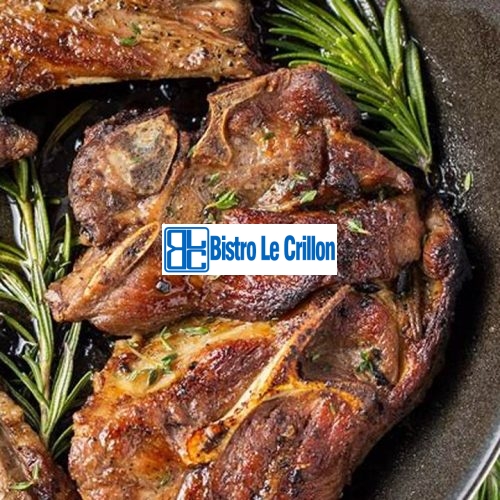
How to Cook Lamb Shoulder
Ingredients
- 1 lamb shoulder approximately 4-5 pounds
- 2 tablespoons olive oil
- 4 cloves garlic minced
- 1 tablespoon fresh rosemary chopped
- 1 tablespoon fresh thyme leaves
- Salt and black pepper to taste
Instructions
- Preheat the oven to 350°F (175°C). Pat the lamb shoulder dry with paper towels and place it on a roasting rack in a roasting pan.
- Drizzle olive oil over the lamb shoulder, then rub minced garlic, chopped rosemary, and thyme leaves all over the meat. Season generously with salt and black pepper.
- Roast the lamb shoulder in the preheated oven for approximately 20 minutes per pound, or until the internal temperature reaches 145°F (63°C) for medium-rare. Make sure to use a meat thermometer for accuracy.
- Remove the lamb shoulder from the oven and let it rest for 10-15 minutes before carving. This allows the juices to redistribute and ensures a tender and juicy roast. Slice the meat against the grain and serve.

